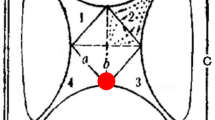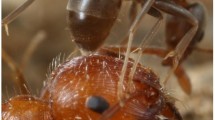Abstract
The red-necked longhorn beetle, Aromia bungii, is an invasive wood-boring insect that has recently invaded Europe and Japan, seriously damaging stone fruit trees in both native and invaded regions. Rose oxide, including both cis- and trans-isomers, was previously found in the volatiles produced by A. bungii adults, while the inter- and intra-specific behavioral functions of this compound remain unclear. By manually shaking the beetles, a much greater amount of rose oxide was released from the beetles, compared to that released from nondisturbed beetles. Rose oxide was further determined to be original from a white-colored secretion which was immediately sprayed by the beetles that were hand captured or squeezed by tweezers. These findings indicate that this pungent compound putatively has a role as an allomone component released from the defensive secretion by A. bungii adults when threatened, which may be an adaptive defensive strategy against the predation of natural enemies such as insectivorous birds. Y-tube olfactory assays revealed that rose oxide, at a high concentration, was significantly repellent to both sexes of A. bungii adults, suggesting that rose oxide may also have a function in the intraspecific communication of A. bungii. Considering the low price of the commercially available products, this repellent effect of rose oxide may facilitate the development of novel control strategies, such as push–pull strategy, for A. bungii.






Similar content being viewed by others
Data availability
The datasets generated during and/or analyzed during the current study are available from the corresponding author on reasonable request.
References
Bai R, Wang Y, Ma S, Jia Y, Lv D (2017) Advance in research of Aromia bungii Faldermann. For Pest Dis 36(2):5–9 (In Chinese with English abstract)
Bashford R (2008) The development of static trapping systems to monitor for wood-boring insects in forestry plantations. Aust For 71(3):236–241. https://doi.org/10.1080/00049158.2008.10675041
Basu S, Clark RE, Fu Z, Lee BW, Crowder DW (2021) Insect alarm pheromones in response to predators: Ecological trade-offs and molecular mechanisms. Insect Biochem Mol Biol 128:103514. https://doi.org/10.1016/j.ibmb.2020.103514
Boch R, Shearer DA, Stone BC (1962) Identification of iso-amylacetate as an active component in the sting pheromone of the honey bee. Toxicon 195:1018–1020. https://doi.org/10.1038/1951018b0
Bruschini C, Cervo R, Turillazzi S (2008) Nesting habit and alarm pheromones in Polistes gallicus (Hymenoptera, Vespidae). J Insect Behav 21(3):123–129. https://doi.org/10.1007/s10905-007-9111-2
Burmeister EG, Hendrich L, Balke M (2012) Der asiatische moschusbock Aromia bungii (Faldermann, 1835) - Erstfund für Deutschland (Coleoptera: Cerambycidae). Nachr Bl Bay Ent 61(1–2):29–31
Chen JR, Yan SY, Cao DD, Jing JR, Zhang K, Jian KM, Ma HF, Wei JR (2020) Mating behavior of Aromia bungii (Coleoptera: Cerambycidae) adults and their perching and oviposition preference on different host plants. Acta Entomol Sin 63(7):851–860. https://doi.org/10.16380/j.kcxb.2020.07.009. (In Chinese with English abstract)
Cook SM, Khan ZR, Pickett JA (2007) The use of push-pull strategies in integrated pest management. Annu Rev Entomol 52:375–400. https://doi.org/10.1146/annurev.ento.52.110405.091407
Di Palma A, Pistillo M, Griffo R, Garonna AP, Germinara GS (2019) Scanning electron microscopy of the antennal sensilla and their secretion analysis in adults of Aomia bungii (Faldermann, 1835) (Coleoptera, Cerambycidae). Insects 10(4):88. https://doi.org/10.3390/insects10040088
EPPO (2012) First report of Aromia bungii in Germany: addition to the EPPO Alert List. EPPO Reporting Service, 2012/090. Paris, France. http://archives.eppo.int/EPPOReporting/2012/Rse-1205.pdf
EPPO (2022) https://gd.eppo.int/taxon/AROMBU/distribution
Germinara GS, Pistillo M, Griffo R, Garonna AP, Di Palma A (2019) Electroantennographic responses of Aromia bungii (Faldermann, 1835) (Coleoptera, Cerambycidae) to a range of volatile compounds. Insects 10(9):274. https://doi.org/10.3390/insects10090274
Greeney HF, DeVries PJ (2004) Experimental evidence for alarm pheromones in the neotropical longhorn beetle, Schwarzerion holochlorum Bates (Coleoptera:Cerambycidae). Coleopt Bull 58(4):642–643. https://doi.org/10.1649/757.1
Hanks LM (1999) Influence of the larval host plant on reproductive strategies of cerambycid beetles. Annu Rev Entomol 44:483–505. https://doi.org/10.1146/annurev.ento.44.1.483
Hanks LM, Millar JG (2016) Sex and aggregation-sex pheromones of Cerambycid beetles: basic science and practical applications. J Chem Ecol 42(7):631–654. https://doi.org/10.1007/s10886-016-0733-8
Henrikson B, Stenson JAE (1993) Alarm substance in Gyrinus aeratus (Coleoptera, Gyrinidae). Oecologia 93(2):191–194. https://doi.org/10.1007/BF00317670
Kano M, Nonaka T, Kiriyama S, Iwata R (2014) Aromia bungii (Coleoptera: Cerambycidae), an invasive cerambycid, found at Soka, Saitama Pref., Japan, infesting cherry trees, Cerasus × yedoensis ‘Somei-yoshino’. For Pests 63:101–105
Kenis M, Hilszczanski J (2007) Natural enemies of Cerambycidae and Buprestidae infesting living trees. In: Lieutier F, Day KR, Battisti A, Grégoire JC, Evans HF (eds) Bark and wood boring insects in living trees in Europe, a synthesis. Springer, Dordrecht. https://doi.org/10.1007/978-1-4020-2241-8_21
Klowden MJ (2008) Physiological systems in insects. Academic Press 01803:293–355. https://doi.org/10.1016/B978-012369493-5
Liedtke HC, Åbjörnsson K, Harraca V, Knudsen JT, Wallin EA, Hedenström E, Ryne C (2011) Alarm pheromones and chemical communication in nymphs of the tropical bed bug Cimex hemipterus (Hemiptera: Cimicidae). PLoS ONE 6(3):e18156. https://doi.org/10.1371/journal.pone.0018156
Ma WH, Sun LW, Yu LG, Wang JT, Chen JY (2007) Study on the occurrence and life history in Aromia bungii (Faldermann). Acta Agric Bor Sin 22:247–249. https://doi.org/10.7668/hbnxb.2007.S2.058
Mondor EB, Roitberg BD (2003) Age-dependent fitness costs of alarm signaling in aphids. Can J Zool 81(5):757–762. https://doi.org/10.1139/z03-053
Noge K, Kakuda T, Abe M, Tamogami S (2015) Identification of the alarm pheromone of Hygia lativentris and changes in composition during development. J Chem Ecol 41(8):757–765. https://doi.org/10.1007/s10886-015-0607-5
Nonato FR, Santana DG, de Melo FM, dos Santos GGL, Brustolim D, Camargo EA, de Sousa DP, Soares MBP, Villarreal CF (2012) Anti-inflammatory properties of rose oxide. Int Immunopharmacol 14:779–784. https://doi.org/10.1016/j.intimp.2012.10.015
Oliver MK (1996) Death-feigning observed in Hippopsis lemniscata (Fabricius) (Coleoptera: Cerambycidae). Coleopt Bull 50:160–161
Rich T, Trentlage B (1983) Caching of long-horned beetles (Cerambycidae: Prionus integer) by the burrowing owl. Murrelet 64(1):25–26. https://doi.org/10.2307/3536019
Russo E, Nugnes F, Vicinanza F, Garonna AP, Bernardo U (2020) Biological and molecular characterization of Aromia bungii (Faldermann, 1835) (Coleoptera: Cerambycidae), an emerging pest of stone fruits in Europe. Sci Rep 10(1):1–9
Schmidt JO (2009). In: Resh V, Carde R (eds) Encyclopedia of insects (Second Edition). Elsevier, Amsterdam, Netherlands, p 255
Smith JW (2009) Aromia bungii (Faldermann): Redneck longhorned beetle Coleoptera / Cerambycidae. New Pest Advisory Group (NPAG), Plant Epidemiology and Risk Analysis Laboratory, Center for Plant Health Science & Technology, APHIS, USDA, USA
Song X, Qin Y, Yin Y, Li Z (2021) Identification and behavioral assays of alarm pheromone in the vetch aphid Megoura viciae. J Chem Ecol 47(740):746. https://doi.org/10.1007/s10886-021-01297-4
Teale SA, Wickham JD, Zhang FP, Su J, Chen Y, Xiao W, Hanks LM (2011) A male-produced aggregation pheromone of Monochamus alternatus (coleoptera: cerambycidae), a major vector of pine wood nematode. J Econ Entomol 104(5):1592–1598. https://doi.org/10.1603/EC11076
Vander Meer RK, Preston CA, Choi MY (2010) Isolation of a pyrazine alarm pheromone component from the fire ant Solenopsis invicta. J Chem Ecol 36(2):163–170. https://doi.org/10.1007/s10886-010-9743-0
Verheggen FJ, Haubruge E, Mescher MC (2010) Alarm pheromones-chemical signaling in response to danger. Vitam Horm 83:215–239. https://doi.org/10.1016/S0083-6729(10)83009-2
Vidari G, De Bernardi M, Pavan M, Ragozzino L (1973) Rose oxide and iridodial from Aromia moschata L. (Coleoptera : Cerambycidae). Tetrahedron Lett 14:4065–4068
Vives E (2000) Insecta, Coleoptera, Cerambycidae. Fauna Iberica. In: Ramos MA et al (eds) Museo Nacional de Ciencias Naturales. CSIC, Madrid, p 716. https://doi.org/10.1016/S0040-4039(01)87113-6
Wang WC, Cao DD, Men J, Wei JR (2018) (R)-(+)-citronellal identified as a female-produced sex pheromone of Aromia bungii Faldermann (Coleoptera: Cerambycidae). Egypt J Biol Pest Control 28: 77 https://doi.org/10.1186/s41938-018-0083-7
Weber DC, Morrison WR, Khrimian A, Rice KB, Leskey TC, Rodriguez-Saona C, Nielsen AL, Blaauw BR (2017) Chemical ecology of Halyomorpha halys: discoveries and applications. J Pest Sci 90(4):989–1008. https://doi.org/10.1007/s10340-017-0876-6
Wei JR, Liu XB, Niu YL, Wang JJ (2013) Identification of volatiles released from the living adult Aromia bungii Faldermann. For Pest Dis 32(5):8–10 (In Chinese with English abstract)
Xu T, Ji BZ, Zhang QD, Liu SW, Ju YW, Ye J, Wu GX, Wang TX (2012) A study on reproductive behavior of Aphrodisium sauteri Matsushita (Coleoptera: Cerambycidae). Chin J Appl Entomol 49(5):1274–1281 (In Chinese with English abstract)
Xu T, Yasui H, Teale SA, Fujiwara-Tsujii N, Wickham JD, Fukaya M, Hansen L, Kiriyama S, Hao DJ, Nakano A, Zhang LW, Watanabe T, Tokoro M, Millar JG (2017) Identification of a male-produced sex-aggregation pheromone for a highly invasive cerambycid beetle Aromia Bungii. Sci Rep 7(1):7330. https://doi.org/10.1038/s41598-017-07520-1
Yasui H, Fujiwara-Tsujii N, Kugimiya S, Haruyama N (2021) Extension of sustained pheromone release for monitoring an emerging invader, red-necked longhorn beetle Aromia bungii (Coleoptera: Cerambycidae). Appl Entomol Zool 56:291–297. https://doi.org/10.1007/s13355-021-00726-w
Zhang RB, Wang B, Grossi G, Falabella P, Liu Y, Yan SC, Lu J, Xi JG, Wang GR (2017) Molecular basis of alarm pheromone detection in aphids. Curr Biol 27(1):55–61. https://doi.org/10.1016/j.cub.2016.10.013
Zou YF, Hansen L, Xu T, Teale SA, Hao DJ, Millar J (2019) Optimizing pheromone-based lures for the invasive red-necked longhorn beetle Aromia bungii. J Pest Sci 92:1217–1225. https://doi.org/10.1007/s10340-019-01108-6
Acknowledgements
We thank Yujie Qing, Hongqi Dou and Leyu Wang for collecting beetles in the field. We thank Nuo Zhang and Yaya Li in chemical analysis. This work was supported by the National Natural Science Foundation of China (No. 32001322), the Natural Science Foundation for Colleges and Universities in Jiangsu Province (No. 20KJB220004), the Science Foundation of Jiangsu Vocational College of Agriculture and Forestry (Nos. 2020kj002 and 2021kj90).
Funding
This work was supported by the National Science Foundation of China (No. 32001322), the Natural Science Foundation for Colleges and Universities in Jiangsu Province (No. 20KJB220004), the Science Foundation of Jiangsu Vocational College of Agriculture and Forestry (Nos. 2020kj002 and 2021kj90).
Author information
Authors and Affiliations
Corresponding authors
Ethics declarations
Conflict of interest
The authors have no relevant financial or nonfinancial interests to disclose.
Consent to participate
Not applicable.
Consent to publish
Not applicable.
Ethical approval
Not applicable.
Additional information
Communicated by Jian Duan.
Publisher's Note
Springer Nature remains neutral with regard to jurisdictional claims in published maps and institutional affiliations.
Supplementary Information
Below is the link to the electronic supplementary material.
Rights and permissions
Springer Nature or its licensor (e.g. a society or other partner) holds exclusive rights to this article under a publishing agreement with the author(s) or other rightsholder(s); author self-archiving of the accepted manuscript version of this article is solely governed by the terms of such publishing agreement and applicable law.
About this article
Cite this article
Chen, R., Chen, C., Zhao, X. et al. Identification and potential application of a putative allomone component in the defensive secretion of a destructive invasive species: the red-necked longhorn beetle, Aromia bungii. J Pest Sci 97, 993–1004 (2024). https://doi.org/10.1007/s10340-023-01649-x
Received:
Revised:
Accepted:
Published:
Issue Date:
DOI: https://doi.org/10.1007/s10340-023-01649-x




